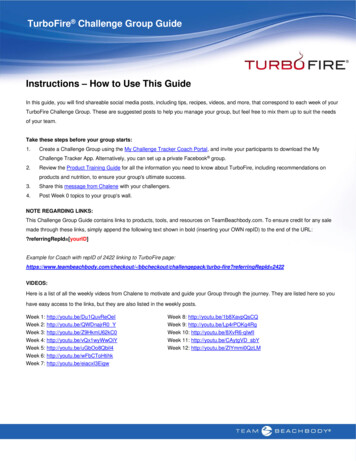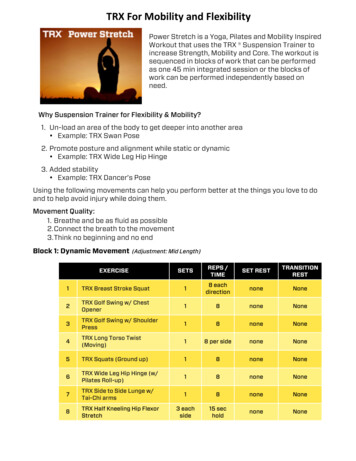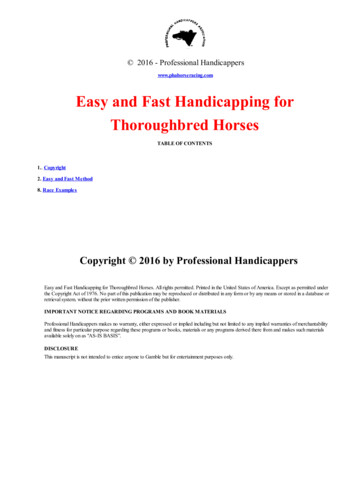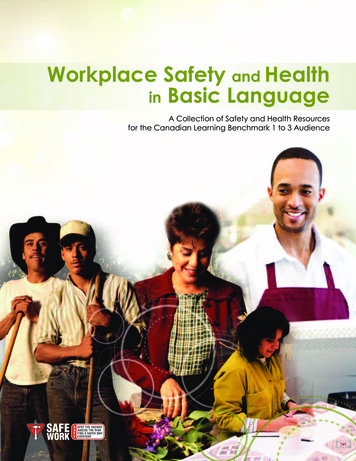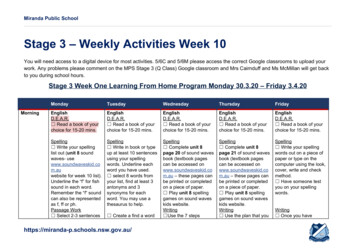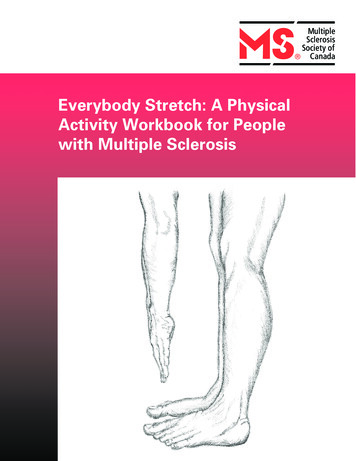
Transcription
Everybody Stretch: A PhysicalActivity Workbook for Peoplewith Multiple Sclerosis
EVERYBODY STRETCHEverybody Stretch: A Physical Activity Workbook for People with Multiple SclerosisBy Janine Fowler, BPE 2003, 2010 Multiple Sclerosis Society of Canada.Further acknowledgements: Special thanks to the Calgary Chapter of the Multiple Sclerosis Society ofCanada, Elizabeth and David Killam, Out-Patient Rehabilitation Program, Calgary, Alberta, Jutta Hinrichs,Ruth Henderson, Linda Janzen, Jennifer Eades, Atul Gadhia and Neera Garga.Dedicated to the memory of Jack A. Scholz.Design and Publishing: Greenwood Tamad Inc.ISBN: 978-1-926803-02-9Multiple Sclerosis Society of Canada(National Client Services and Research), 2010Legal Deposit –National Library of Canada
COVER ARTWORKJanet LeducI Think I Can, CharcoalJanet has lived with primary progressive multiple sclerosis for twenty years.Although she is not a self-declared artist, her passion for exercise inspiredher to sketch I Think I Can for the cover of this manual.When she was diagnosed, the first thing that came to her mind was the fearthat she would no longer be able to walk. This was a part of her life thatshe did not want to lose. Twenty years ago it was suggested to her byhealth care professionals that she should quit her job and go home to rest.She disagreed with this outlook. Instead, she continued to work fornineteen years and exercised daily.Over the years, she has had to change the nature of her exercise regime;she replaced her aerobics, skating, skiing and jogging with swimming,walking on a treadmill, golfing with a cart and practicing yoga.‘We must persist to be the best we can be physically and mentally. I knowthat if I was not committed to such a self-challenging exercise routine Iwould not be able to walk today.’
EVERYBODY STRETCHTable of ContentsForeword . 3Introduction . 3Benefits of Flexibility. 4Important information before you start. 4Exercise and multiple sclerosis . 4What to look for in exercise professionals . 5Information to share with exercise professionals . 5Tips before starting . 6How to use this workbook . 7How to adapt exercises . 8How to stretch . 9How to use the exercise routine work sheet . 10Exercise routine work sheet . 11How to use your exercise log . 12Exercise log . 13SECTION 1: Breathing control . 14SECTION 2: Eyes and face . 16SECTION 3: Neck . 19SECTION 4: Shoulders . 20SECTION 5: Upper arms . 21SECTION 6: Forearms . 23SECTION 7: Hands . 25SECTION 8: Chest and back . 27SECTION 9: Abdominals . 32SECTION 10: Buttocks . 34SECTION 11: Upper legs . 35SECTION 12: Lower legs and feet . 38Glossary . 40References . 41Resources . 412www.mssociety.ca
EVERYBODY STRETCHForewordExercise is recognized as an important step toward wellness when living with a chronic illness. Thebenefits of exercise are numerous and include reduction in fatigue, spasticity and pain, as well asimprovement in muscle tone, strength and overall endurance. Everybody Stretch helps individuals designan exercise routine under the supervision of a health professional regardless of their level of ability. Theprogram’s step-by-step instructions and pictures make following a regular schedule fun and easier toincorporate into daily routines. As a nurse involved in MS care for over 20 years, I would highlyrecommend Everybody Stretch to individuals who want to maintain wellness through regular physicalactivity.Colleen Harris, RN, MN, MSCNNurse Practitioner/Nurse CoordinatorUniversity of Calgary MS ProgramIntroductionManaging your own well-being often begins with the choices you make on a daily basis. Such choicesmay involve diet, physical activity and the determination to enjoy life.Choosing to participate in physical activity is up to you. You can develop a personalized routine to suityour level of ability, but it is important to try to maintain it regularly. Before you begin any form ofexercise, please be sure to consult your doctor. Let your doctor know that you want to include physicalactivity in your healthy lifestyle. This workbook will focus on flexibility, range of motion, and some mildmuscular strength and endurance. As you go through these activities, you will learn about theimportance of exercise and MS. You will also develop your own individualized routine step-by-step.As your condition changes, this workbook will allow you to go back and change areas of your routine,making it more or less challenging wherever necessary. There are many benefits of a regular stretchingregime. Physical activity will make you feel better mentally, emotionally and physically, and help you gainor maintain a sense of control over your life.www.mssociety.ca3
EVERYBODY STRETCHBenefits of Flexibility Enhanced physical fitness.Improved ability to learn and perform skilled movements.Increased mental and physical relaxation.Development of body awareness.Reduced muscular soreness.Reduced muscular tension.Decreased stiffness.Improved management of MS related spasticity.Increased resistance to tissue injury (ligaments, tendons, muscles).IMPORTANT INFORMATION BEFORE YOU STARTNot just MS!This workbook has been designed with multiple sclerosis in mind; however, the content of this activitybook is adaptable to other physical disabilities. These exercises are basic movements that focus on allthe major muscle groups. Make sure you involve your physician and physiotherapist in deciding whichexercises are appropriate for you.Exercise and Multiple SclerosisBecause multiple sclerosis affects individuals in so many different ways, it is impossible to outline asingle, simple exercise program that’s right for everyone. For this reason, this workbook has beendesigned to allow YOU to pick and choose the routines that are best for your level of ability. The effectsof MS may vary considerably over time for different individuals. As a result, what may be a suitableexercise at one time may be inappropriate at another. Thus, an exercise program for multiple sclerosismust be personalized and may need to change as your condition changes. It is okay to change parts ofyour routine or to use an aid to perform a stretch.4www.mssociety.ca
EVERYBODY STRETCHWhat to look for in exercise professionalsMake sure that you involve qualified professionals in individualizing your exercise regimen andremember to check out their qualifications. Look for the following when choosing exercise professionals: Detailed knowledge of multiple sclerosis, or willingness to learn. Knowledge of community resources for people living with MS. Exercise-related training such as a degree or a certification approved by a national organization, suchas the Canadian Physiotherapy Association (CPA). A good example is the National Fitness AppraisalCertification and Accreditation (FACA), which is granted by the Canadian Society for ExercisePhysiology (CSEP) and supported by the federal government. Talk to your physician about anyprofessionals you plan to consult.Information to give to exercise professionalsIt may be difficult to know what to tell exercise professionals about your condition. Sometimes you maynot wish to share all of your medical history with people. Remember that you have the right to discloseonly what you feel comfortable with. The following list may help you decide what information to givethose who assist you with your exercise regime: Symptoms you have on a daily basis. Medications you use for physical symptoms (e.g. spasticity). The time of day you have the most energy. The type of MS relapses you have experienced. Any mobility aids you use and the types of assistance you need (e.g. for changing clothes, openingdoors, going down stairs, dialing a phone number). Your favourite activities (e.g. gardening, walking, using the computer). Your activity level: do you exercise every day, twice a week, or once a month? Your goals (e.g. general fitness, improved flexibility, ability to hold a pen or pencil).www.mssociety.ca5
EVERYBODY STRETCHTips before starting Talk to your doctorIt is recommended that you discuss any exercise program with your physician prior to starting it. Perhapsyou can share this workbook with your physician or physiotherapist. Ask for guidance as to whichexercises are most appropriate for you. It’s okay to stop and startMS may be constantly interrupting your daily routine, which can be very frustrating. Try to be realisticabout exercise. One thing MS teaches you is to know your limits. Remember this when exercising:it’s okay to rest, it’s okay to take a day off, and it’s okay to do only 15 minutes instead of your regular30 minutes. You can still have a regular exercise routine even if you have to adjust it. Do not begin anexercise program during the course of an MS relapse unless you are so advised by your physician.Also, after an MS relapse, re-evaluate your routine with your physician. Make the necessary changesand assess whether it is realistic to pick up where you left off prior to your MS relapse. Begin againslowly and build up your routine.Exercise and overheatingGetting hot while exercising can temporarily increase MS symptoms such as spasticity and/or fatigue.If you are using some form of resistance in a stretch, such as pushing against a wall or pulling against astrap, then the harder you work against the resistance, the more likely you are to get overheated.Be aware of how much exertion is right for you and be sure to rest during your routine. Learn to paceyourself and aim for slow, steady gain. As an alternative, you may consider aquatic exercise programs tohelp keep your temperature regulated. There are a variety of programs available. Check in your localcommunity. Make sure you speak with the instructor prior to any classes to address any needs you mayhave during the class. Be sure to inquire about the temperature of the pool, since therapeutic pools areoften heated.Fatigue and MSFatigue has a powerful effect on physical activity and physical fitness. Fatigue makes individuals with MSweaker by sharply reducing activity levels. Without activity, muscles weaken, especially the muscles thatare used to breathe. This progressive weakness causes people with MS to further decrease their activitylevels, making fatigue even worse, in a vicious cycle. Regular exercise has many important benefits for6www.mssociety.ca
EVERYBODY STRETCHsomeone who experiences fatigue. It increases lung capacity and the body’s ability to use oxygeneffectively. It preserves or increases muscle flexibility and can reduce pain. It increases strength andenergy reserves. It can help strengthen the respiratory muscles and can also help to relieve feelings ofdepressed mood, anxiety, and stress, all of which have been linked to fatigue.MotivationStaying motivated can be challenging, especially if you are recovering from an MS relapse. Keeping anexercise log is a great way to stay motivated. On page 12 you’ll find a sheet and directions on how tostart an exercise log. This way, if you have a setback, you can look at your log to see how you improvedand how you felt. Hopefully, this will help you regain your motivation. Make your routine as enjoyable aspossible. Wear comfortable clothing that does not restrict movement. Experiment with different times ofday to find out the best period(s) for you to exercise. Some people prefer to break their exercise sessioninto two parts, one in the morning and one in the afternoon or evening.Listen to your bodyWhen beginning any exercise program, go slowly. Do not force any part of your body or push yourselfbeyond your comfort limit. If you experience any pain or discomfort during any exercise, stopimmediately. Check with your physician or physiotherapist before doing that exercise again.Two hour ruleIf you don’t feel as well two hours after exercising as you did before you started exercising then youprobably did too much that session.HOW TO USE THIS WORKBOOKThis workbook is designed so that you can create your own stretching program. There are 12 sections,each of them emphasizing a different muscle or muscle group. In each section you will find EssentialExercisesas well as Optional Exercises. There are three different versions or “Adaptations” ofeach exercise. Please note that the various adaptations do not indicate level of difficulty; they simplyprovide options to suit different abilities. Choose the one that works best for you. In the end, you willhave a custom-made stretching program that can be altered at any time to suit your needs.Ewww.mssociety.ca7
EVERYBODY STRETCHHow to choose exercisesRead through each exercise and look at the different adaptations available. Decide which one is best foryou based on the following criteria:BALANCE:Make sure you feel stable and safe.FATIGUE:Be aware of your fatigue levels. For example, if standingis tiring for you, choose a seated position toconserve energy.COORDINATION: Choose a position you can easily hold.COMFORT:Make sure you feel comfortable in the stretchingposition.HOW TO ADAPT EXERCISESTo get the most out of your program, adaptations are crucial. Adaptations are suggested in each section.But in the meantime, here are some basic principles. Use an assistantAsk a friend, family member or fellow exerciser to assist you as you move into stretching positions. In apassive stretch, your assistant can stretch your muscles for you. Be sure to keep your muscles relaxedand communicate to your assistant how the stretch feels. Use a strapIf no assistant is available, you can use some form of strap to help in your stretches. A towel, dress tie,pair of tights or piece of sturdy fabric works fine. (Avoid plastic or rubber, which could affect yourcirculation.) For example, in the Adaptation 1 version of “Ankle Circles” (Section 12), you can use a strapto help you raise your ankle into position. You can also use a strap to hold your arms in a certainposition (for example, the triceps stretch in Section 5).8www.mssociety.ca
EVERYBODY STRETCH Using wallsUse the walls that are all around you! A wall can be a support for your back or just something to holdon to when you stand. You can also use a wall to hold your stretches (for example the biceps stretch inSection 5). Doorways, headboards and the backs of chairs can also provide effective support whilestretching. Using propsIf you are feeling unstable while doing stretches, prop pillows on either side of you. They will give yousome stability and cushion you should you lose your balance.What if the suggested adaptations don't work for me?Remember that the suggested adaptations are just that - suggestions. If they don't work for you, ask anexercise professional to help you find other ways to do the stretches. Share your ideas with others andask what works for them.What if I have to change my program?When your body's abilities change, you have to change with them. You may find at times that there aresome parts of your exercise routine you are no longer able to do. But there will be others you can stilldo, although you may have to modify them. If one component of your exercise program is not workingor you need to adjust a few exercises due to changes in your MS, just go back to that section andchoose a different adaptation. Add the new adaptation of that exercise into your program. You may haveto go back and choose an entirely new program if you are recovering from an MS relapse. You are notstarting over; you are adapting to change. Slowly build your way up again.HOW TO STRETCHIt is very important to understand the proper technique for stretching. If you have questions, pleaseconsult an exercise professional. Begin by stretching the muscle slowly. Take that stretch to a point youcan hold comfortably while still feeling tension in your muscles. You should hold stretches longer forlarger muscles. Listen to your body to figure out the right time for you – anywhere between 30 and 60seconds. You can also measure lengths of time by deep breaths. See how long a deep breath usuallytakes you and use that to time your holds. For each stretch, follow these steps: Take a deep breath. Reach slowly into the stretch while exhaling.www.mssociety.ca9
EVERYBODY STRETCH Hold the stretch at a point that is comfortable but still creates tension in your muscles.Remember to breathe deeply.Hold the stretch until you feel you might be able to stretch it a little farther – but don't.Take a deep breath.While exhaling, slowly bring the stretch back to your beginning position.Relax that muscle or muscle group for 30-60 seconds.Repeat the stretch as appropriate.Numbing, tingling or functional lossYou should never feel pain while stretching. If you are not always aware of your muscles due tonumbness, tingling or functional loss, it is easy to injure yourself. If you have limited sensation in oneparticular area, stretch lightly and think about how other parts of your body would react to a similarstretch. Be aware of your body at all times.Do not stretch beyond what you can comfortably hold. If you are using an aid, such as a wall or a strap,do not use these to force your muscles beyond your comfort point. Remember that stretching is aboutslow, controlled movements. If you move too quickly or forcefully, you can injure yourself. If you areuncertain of how far to carry a stretch, please speak to an exercise professional or your physician.How to use the Exercise Routine Work SheetStep 1Photocopy the exercise routine work sheet on the following page or write lightly in pencil so that youcan change your routine as needed.Step 2Go through the workbook section by section. Experiment with the exercises, and for each one choosethe adaptation that is most appropriate for you, based on the criteria discussed: balance, fatigue,coordination, and comfort. Enter the adaptation you have chosen in the column labelled “ADAPTATION.”Step 3Post your routine on your fridge or some other place you pass by regularly. This should encourage you todo the routine regularly.10www.mssociety.ca
www.mssociety.caSECTION 6SECTION 5SECTION 4SECTION 3SECTION 2SECTION 1EESlow LeakLocating Your Diaphragm OptionalOETwisting ReachTorso TwistsEShoulder RollsEEQuadricepsHamstringsODoor KnobOEWrist Circles EssentialOToesEForearmsEOFoot Flexion/ExtensionFOREARMSLOWER LEGS AND FEETEHip FlexorUPPER LEGSEETricepsSECTION 12SECTION 11Ankle CirclesEBicepsUPPER ARMSEShrugsSHOULDERSButtock StretchEEForward Head RollBUTTOCKSEChin RollSECTION 10OABDOMINALSECross-OverAbdominal StretchSECTION 9ERhomboidsEOFacial MassageEFingersEar to ShoulderOAEIOUOHand MassageCHEST AND BACKOFistsHANDSEELemons and Roller CoastersSECTION 8SECTION 7Seated CrunchesENear and Far FocusLEVELNECKEClockEYES AND FACEEDeep BreathingBREATHING CONTROLExercise Routine Work SheetLEVEL
EVERYBODY STRETCHWhy is an Exercise Log important?The Exercise Log enables you to chart your progress and see any improvements you have made. It’s alsoa great tool for your health care team. It helps them see progression, difficulties, improvements andother factors to help them determine treatment and therapy for you.How do I use the Exercise Log?First, it is not necessary to write in your log every day. Try to write in it at least once a week. This log willhelp measure how you felt that day physically and emotionally and note any achievements or difficulties.You may want to photocopy the log sheet on the page that follows or find a book where you can recordthe information. Just fill in the date, then record how many days it is since the commencement of yourprogram. Rate both your physical and emotional state on a scale of 1-10. Use the following criteria as aguide to mark on your log where you are on that particular day. For example, I am feeling good today.no new symptoms or worsening symptoms. my arm is feeling a little more relaxed since yesterday and Ihave more movement in my left foot. today I would put myself at 6, or maybe 7.Physical Rating01 I am feeling worse than usual. New symptoms or worsening symptoms are present.I think I need to see my family physician.05 I don’t feel better or worse. Some of the symptoms that I normally have are present,but it is nothing I haven’t had before.10 I am feeling great! I have improved a lot since my last session. I still may not be ableto do some things, but I can see tremendous improvement.Emotional Rating1201 I am very sad or angry today. I am very frustrated with the way things are going.I just want to lie in bed. If I feel this way for more than two weeks, I should call mydoctor. I can’t do this anymore!05 I don’t know how I feel today. I guess I am just neutral. I’ll go through my regularroutine today.10 Today is a great day! I feel so positive about my life. I’m going to call a friend andmaybe go somewhere special. I’m looking forward to every part of my day!www.mssociety.ca
EVERYBODY STRETCHDateDayof my programPhysical Rating1234567891078910Emotional Rating123456CommentsDateDayof my programPhysical Rating1234567891078910Emotional Rating123456Commentswww.mssociety.ca13
EVERYBODY STRETCHSECTION 1BREATHING CONTROLBy being aware of our breathing, we can become more aware of our bodies. Sit quietly and listen to your breathing. Describe your breathing. Is it fast, short, long, deep, shallowor laboured? Now take a deep breath, hold it and slowly exhale. Do this two more times. Now listen to your breath. Has it changed? Is it the same? Do you feel differently?The following exercises will help you focus on your breathing and hopefully improve it.CAUTION: If you become dizzy, light-headed or experience anything unpleasant as a result of theseexercises, discontinue them and consult your physician.EDeep BreathingThis exercise slows your heart rate and helps you to relax. Take a full, slow inhalation. Hold for 1-3 seconds. Exhale fully and slowly.Repeat 3-6 times.14www.mssociety.ca
SECTION 1EEVERYBODY STRETCHSlow LeakThis exercise helps you to recognize full exhalation. Notice how your abdominals work at the end of theexhalation. Take a full, slow inhalation. Exhale slowly. Toward the end of the exhalation, exhale by making a quiet ‘HEE’ sound. ‘HEE’ as long as you can.Repeat 3-6 times.ELocating Your DiaphragmThe diaphragm is a muscle between the abdomen and thorax (chest) that assists in breathing. Thisexercise helps you to learn to breathe with your diaphragm: Place your hands on your stomach, or focus on your stomach area. Inhale slowly. Your stomach should move out as you inhale. Your shoulders should not move when you inhale or exhale. Exhale slowly. Your stomach should move in while you exhale.Repeat 3-6 times.www.mssociety.ca15
EVERYBODY STRETCHSECTION 2EYES AND FACEGiven the number of muscles around your eyes and in your face, it makes sense to exercise them. Youcan do these exercises while listening to music or the radio in the privacy of your home.EClockThis exercise really stretches all of the little muscles around your eyes. Find a spot on the wall that represents 12 o’clock. Keep your head stationary. Move your eyes around the clock according to the options below (Adaptation 3, Adaptation 2 orAdaptation 1) at 3-second intervals. Repeat counter-clockwise.Repeat 2 times in each direction.16Adaptation 3Adaptation 2Adaptation 1Move your eyes from 12 to1, 2, 3, 4 etc.Move your eyes from 12 to3, 6, 9 and back to 12.Move your eyes from12 to 6 and back to 12. Thenmove your eyes from 9 to 3and back to 9.www.mssociety.ca
SECTION 2EEVERYBODY STRETCHNear and Far FocusThis exercise lets you really concentrate on your eyes’ focusing abilities. Hold thumb approximately 15 cm/ 6 inches away from your eyes. Focus on your thumb for 5-10 seconds. Bring your focus to the wall beyond your thumb and hold for 5-10 seconds. Bring your focus back to your thumb. Always finish this exercise when you are focused on the wall.Repeat 3 times.Adaptation 3Adaptation 2Adaptation 1Follow the steps outlinedabove.Instead of your thumb, focuson something in the middleof the room that is at eyelevel e.g. a lamp, pillar, orcabinet.Focus on the wall, then closeyour eyes. Open your eyesand focus on the wall again.E Lemons and Roller CoastersScrunch up all of your facial muscles and eyes as if you have just eaten a lemon.Hold for 5-10 seconds.Open up the face and eyes as if you are going downhill on a roller coaster.Hold for 5-10 seconds.Repeat 2 times.www.mssociety.ca17
EVERYBODY STRETCHSECTION 2AEIOU Say the vowels out loud. Open your mouth, eyes, nose etc. up as much as you can during each vowel. Really try to overemphasize your facial expressions.Repeat 3 timesAdaptation 3Adaptation 2Adaptation 1Sound out the vowels andmake facial expressions.Sound out the vowels andmake expressions with yourmouth.Make expressions with yourmouth.Facial Massage Using your ring fingers, make very small circular rotations, starting at the bridge of your nose, thenacross your brow line to the temples. Move from the temples to the top of your jaw and proceed toward your chin. Move from the chin, up to your cheekbones, then over to your ears. Follow the base of your skull to the back of your head.Repeat as needed.18Adaptation 3Adaptation 2Adaptation 1Use finger tips.Use palms and backsof hands.Use forearms.www.mssociety.ca
SECTION 3EVERYBODY STRETCHNECKThe neck holds up the head, and the average human head weighs eight pounds (about 3.5 kilograms).If you had to hold eight pounds in your hand above your head all day, imagine how tired those armswould be! A lot of our tension is carried in our neck and shoulders, so it’s important to make time forthese exercises. Compare how you feel before and after doing these exercises.E Ear to ShoulderFacing forward, tilt your head so your ear is closer to one shoulder.Your shoulder should be relaxed and dropped slightly.Try holding for 30 seconds.Drop head forward slightly so you are looking downward, still tilted to the side.For a stronger stretch, let the opposite arm (if tilting to left, use right arm) hang by your side andreach toward the ground.Repeat 2-3 times on each side.EChin Roll Pretend you have a tennis ball under your chin. Extend your chin forward over the pretend tennis ball and drop chin. Drop your chin as if rolling yourneck over the tennis ball. Bring chin down as far as comfortable; it should not touch your chest. Bring chin up as if the tennis ball is still tucked under your chin.Repeat 2 times.EForward Head Roll Drop your head to one shoulder and roll head forward slowly from one shoulder to the other. Roll only to the front and sides. Do not roll your head backwards.Repeat 10 times.www.mssociety.ca19
EVERYBODY STRETCHSECTION 4SHOULDERSThere are many muscles involved in shoulder
Physical activity will make you feel better mentally, emotionally and physically, and help you gain or maintain a sense of control over your life. EVERYBODY STRETCH 4 www.mssociety.ca Benefits of Flexibility Enhanced




